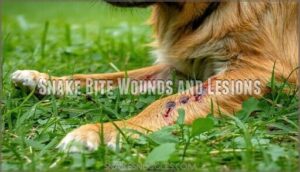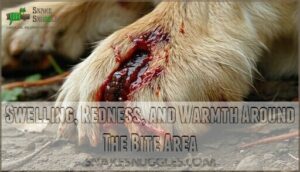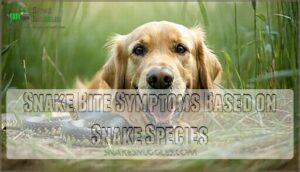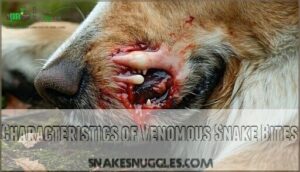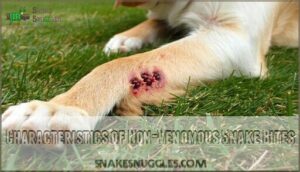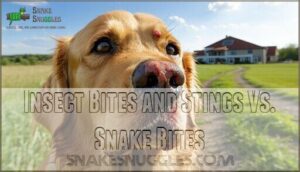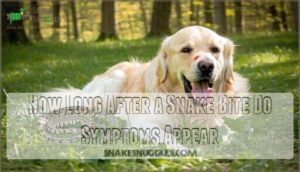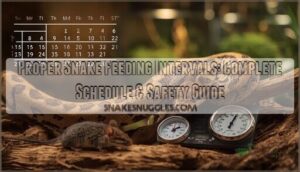This site is supported by our readers. We may earn a commission, at no cost to you, if you purchase through links.
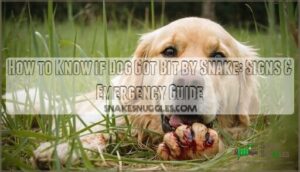
Your pup might suddenly become lethargic, start panting heavily, or show signs of pain like whining or reluctance to move.
Watch for more serious symptoms like vomiting, difficulty breathing, or dilated pupils – these signal venom’s doing its dirty work.
Even non-venomous bites cause swelling and bleeding. Time’s your enemy here, so don’t play detective too long.
The tricky part? Sometimes bite marks hide under thick fur, making other warning signs your best clues.
Table Of Contents
- Key Takeaways
- Identifying Snake Bite Symptoms
- Common Signs of Snake Bites in Dogs
- Dog Behavior After a Snake Bite
- Snake Bite Symptoms Based on Snake Species
- How to Check Your Dog for Snake Bites
- Snake Bite Wound Identification
- How Long After a Snake Bite Do Symptoms Appear
- Can You Always See The Snake Bite Wound
- How to Distinguish Snake Bites From Other Injuries
- What to Do if You Suspect a Snake Bite
- Frequently Asked Questions (FAQs)
- How do I know if my dog has a snake bite?
- What if my dog gets bitten by a snake?
- How do you know if a snake bite is venomous?
- Should I give my Dog a snake bite?
- How do you know if a dog has been bitten?
- What snake bites a dog?
- How do you know if your dog has been bitten by a snake?
- How soon after a snake bite will a dog show symptoms?
- Can a dog survive a snake bite?
- Does a snake bite look like on a dog?
- Conclusion
Key Takeaways
- Look for two puncture wounds about half an inch apart with rapid swelling spreading beyond the bite area – you’ll often find these marks hidden under your dog’s fur, especially on the head, neck, or legs where snakes typically strike.
- Watch for immediate behavioral changes like sudden lethargy, muscle tremors, vomiting, dilated pupils, or collapse followed by apparent recovery – these symptoms can appear within 30-60 minutes for most venomous bites but may take up to 18 hours with coral snakes.
- Don’t wait to see if symptoms develop – get your dog to an emergency vet immediately even if you’re not sure it’s a snake bite, since antivenom works best when administered quickly and survival rates drop significantly with delayed treatment.
- Keep your dog calm during transport by carrying them to prevent faster venom circulation, remove any collar near the bite site to prevent choking from swelling, and avoid home remedies that can waste precious time or worsen the situation.
Identifying Snake Bite Symptoms
When you’re worried your dog might’ve encountered a snake, you’ll need to watch for specific warning signs that can appear within minutes or take hours to show up.
Recognizing these symptoms quickly can mean the difference between a full recovery and a life-threatening emergency, so knowing what to look for becomes your most important tool as a pet owner.
Recognizing Collapse and Apparent Recovery
When your dog suddenly collapses then quickly recovers, don’t brush it off as simple clumsiness.
Don’t dismiss sudden collapse and recovery as clumsiness—it’s often a warning sign of venomous snake bite.
This Initial Collapse followed by False Recovery often signals serious dog snake bite symptoms.
The Underlying Damage from venom continues working despite your pet’s apparent bounce-back.
These Missed Symptoms can lead to deadly snake bite complications, making immediate veterinary attention essential for improving Prognosis Implications and your dog’s survival chances.
Lethargy, Muscle Tremors, and Reduced Eye Blinking
When your dog shows lethargy, muscle tremors, and reduced eye blinking, these snake bite symptoms signal serious trouble.
The venom’s attacking their nervous system, making immediate vet care essential. Watch for tremor severity that worsens quickly – it’s your clearest warning sign.
Digestive upset can also manifest, but anorexia is also possible.
Key muscle weakness indicators include:
- Sudden wobbliness or loss of coordination (ataxia)
- Uncontrollable shaking throughout the body
- Slower eye blinking rate than normal
- Progressive lethargy causes complete exhaustion.
Don’t wait – symptom progression happens fast with venomous bites.
Dilated Pupils, Weakness, and Paralysis
Watch your dog’s eyes closely—dilated pupils signal neurological snakebites affecting the nervous system.
Venom weakness impact starts subtly, with wobbly legs progressing to complete paralysis. Bite paralysis onset varies, but pupil dilation causes immediate concern.
You’ll notice your pet struggling to stand or walk normally as paralysis progression speed accelerates. These snake bite symptoms demand urgent action since neurological damage worsens quickly without treatment.
Dilated Pupils
Muscle Weakness
Paralysis
These symptoms are serious indicators of a venomous snake encounter.
Loss of Bladder and Bowel Control
Beyond dilated pupils and weakness, snake venom can trigger neurological damage leading to sphincter dysfunction.
Your dog might lose bladder and bowel control, signaling severe envenomation requiring immediate veterinary diagnosis.
Snake bite symptoms like this indicate:
- Your pet’s nervous system is under attack
- Muscle weakness is spreading rapidly
- Dehydration risks are mounting quickly
- Emergency treatment can’t wait another moment
Discolored, Dark Urine
Noticing dark urine signals serious trouble after a snake bite dog encounter.
Red urine indicates kidney involvement and internal bleeding from snake venom dog exposure.
| Urine Color | Possible Cause | Action Needed |
|---|---|---|
| Dark Red/Brown | Hemoglobinuria causes from venom | Emergency vet visit |
| Cola-colored | Myoglobinuria effects from muscle damage | Immediate treatment |
| Pink/Red | Blood in urine | Diagnostic urine tests required |
| Normal Yellow | No kidney damage yet | Continue monitoring closely |
Snake bite signs include these alarming urine color changes requiring instant veterinary care.
Common Signs of Snake Bites in Dogs
You’ll spot the most obvious signs of a snake bite by checking your dog’s body for visible wounds, swelling, and unusual bleeding.
These physical markers, combined with your dog’s behavior changes, will help you quickly identify whether your pet needs emergency veterinary care, which can be critical for emergency situations.
Snake Bite Wounds and Lesions
After a dog snake bite, puncture wound visibility often depends on fur thickness and wound location significance.
Snake bite wounds may appear as tiny fang marks or larger tears with bleeding characteristics varying by species.
- Puncture wounds: Often hidden beneath fur, requiring careful parting of hair
- Tissue damage progression: Skin may darken or bruise around bite site
- Wound patterns: Single or paired marks indicating different snake types
Swelling, Redness, and Warmth Around The Bite Area
Looking for tell-tale signs? Swelling duration around a dog snake bite typically develops within minutes, while redness extent spreads beyond the initial puncture wounds dog received.
The warmth significance indicates your body’s inflammatory response to venom.
Check the bite location carefully – fang marks dog show as paired holes.
Monitor infection risk closely, as dog bite wound complications can worsen rapidly without proper veterinary care.
Bleeding or Discharge From The Bite Wound
Bleeding or discharge from a dog snake bite wound signals serious venom damage that demands immediate attention.
Puncture wounds dog often show fang marks dog with continuous oozing or dark, bloody discharge. Bleeding severity varies by wound location – neck and chest bites bleed more profusely than limb wounds.
Clotting issues from venom prevent normal healing, while discharge appearance ranges from clear fluid to thick, discolored pus. This dramatically increases infection risk.
Don’t wait – dog bite wound bleeding means your pup needs emergency veterinary care now, not later.
Dog Behavior After a Snake Bite
Your dog’s behavior often changes dramatically after a snake bite, serving as one of the clearest warning signs that something’s seriously wrong.
You’ll notice shifts in eating habits, increased restlessness or whining, and a reluctance to move around normally as your pet tries to cope with pain and potential venom effects, which can be a clear indication of the severity of the situation, highlighting the importance of recognizing warning signs.
Changes in Appetite and Water Intake
Snake bites often trigger noticeable changes in appetite and water intake.
Your dog might show loss appetite or complete refusal food, making mealtime a struggle.
You’ll spot increased thirst as venom affects their system, or notice difficulty swallowing that prevents normal eating.
Watch for dehydration signs like dry gums—these behavioral shifts signal your dog needs immediate veterinary attention after a potential snakebite.
Whining, Panting, or Restlessness
Panic sets in when your dog shows clear distress signals after a potential snake encounter.
These behaviors indicate your dog bitten by snake needs immediate attention.
Watch for these critical stress signals:
- Whining – Pain indicators your dog can’t verbally express
- Excessive panting – Fear response beyond normal breathing patterns
- Restlessness – Inability to settle, pacing frantically
- Seeking comfort – Unusual clinginess or hiding behavior
Contact your emergency vet immediately.
Avoiding Movement or Activity
When your dog becomes a couch potato overnight, it’s often a red flag.
A dog bitten by snake will avoid movement and seek Safe Spaces, appearing unusually dog lethargic bite.
This behavioral shift signals potential snake bite symptoms in dogs, as pain makes them reluctant to move.
| Behavior | Normal Activity | Post-Bite Response |
|---|---|---|
| Walking | Enthusiastic, energetic | Reluctant, slow |
| Playing | Active engagement | Avoids interaction |
| Exercise | Enthusiastic participation | Limited Exercise tolerance |
Snake Bite Symptoms Based on Snake Species
Not all snake bites create the same emergency for your dog, since different species produce vastly different symptoms and timelines.
You’ll need to recognize whether you’re dealing with a venomous bite that requires immediate antivenom treatment or a non-venomous bite that mainly needs wound care and infection prevention, which can be a matter of immediate action.
Venomous Snake Bites and Their Symptoms
Venomous snake bite symptoms in dogs appear fast and hit hard. Your dog’s behavior shifts dramatically after encounters with dangerous species.
Venom Effects create Systemic Reactions within minutes. Puncture Wounds may be small, but Rapid Swelling spreads quickly. Watch for Pale Gums, indicating shock.
The severity of the bite depends on venom composition and effects.
Key venomous snake bite symptoms include:
- Dog lethargic bite response with sudden weakness
- Dog swelling bite area expanding beyond wound site
- Muscle tremors and uncontrollable shaking
- Dark, bloody urine from internal damage
- Difficulty breathing and irregular heartbeat
Non-Venomous Snake Bites and Their Symptoms
Good news: nonvenomous snake bite injuries typically cause minor puncture wounds and localized swelling around the affected area.
You’ll notice bruising extent varies, but dog bite wounds heal faster than venomous encounters.
However, infection risks remain serious concerns requiring veterinary attention.
Dog swelling bite symptoms usually resolve within 48 hours, though pain management and antibiotics prevent dog bite infection complications.
Many non-venomous species exhibit diverse physical traits.
Regional Snake Species and Their Symptoms
Knowing your local snake species can save your dog’s life.
Different regions harbor unique threats requiring specific awareness.
- Coral Snake Symptoms: Delayed paralysis and respiratory distress appearing hours after the bite
- Rattlesnake Effects: Immediate swelling, bloody discharge, and severe tissue damage around puncture wounds
- Copperhead Signs: Moderate swelling with less systemic toxicity than other venomous species
Proper snake identification prevents panic.
How to Check Your Dog for Snake Bites
When you suspect your dog has been bitten by a snake, you’ll need to conduct a thorough but gentle examination to look for bite marks, swelling, or signs of distress.
Start by checking your dog’s head, neck, and legs first, since these areas are most commonly targeted, while also watching for behavioral changes like excessive panting, drooling, or unusual lethargy, which can indicate a snake bite and require immediate attention for distress.
Examining The Dog’s Body for Wounds
After identifying potential snake species involved, you’ll need to systematically examine your dog’s body for telltale wounds. Start by gently parting the fur to look for puncture wounds—they’re often smaller than you’d expect. Check common bite locations first: head, neck, and legs where dogs typically encounter snakes.
| Body Area | What to Look For | Common Signs |
|---|---|---|
| Head/Face | Swelling patterns, puncture wounds | Facial distortion, drooling |
| Neck/Chest | Bruising location, bite marks | Rapid swelling, difficulty breathing |
| Legs/Paws | Small wounds, limping | Favoring limb, localized swelling |
| Body/Belly | Hidden wounds, sensitivity | Reluctance to move, tender areas |
Use gentle palpation techniques to feel for swelling or heat around suspicious areas. Hair obscuring wounds makes dog snake bite identification tricky, so run your hands slowly over your pet’s body. Snake bite bruising appears as dark discoloration, while snake bite swelling spreads beyond the initial wound site. Remember, snake bite puncture wounds might look like tiny needle pricks rather than obvious dog wounds. Proper treatment may require specialized wound care to prevent infection.
Checking for Signs of Pain or Discomfort
Beyond visible wounds, your dog’s body language speaks volumes about hidden pain from a potential snakebite. Dogs instinctively mask discomfort, making careful observation essential for detecting symptoms like bruising and swelling.
Watch for these key signs of snakebite pain:
- Limping or lameness – favoring one leg or reluctant movement
- Vocalizations of pain – whimpering, whining, or unusual crying sounds
- Guarding behavior – protecting the bite area from touch
Notice sensitivity to touch around suspected bite sites, changes in posture like hunching or stiffness, and reluctance to move normally. These subtle cues often reveal what your dog can’t tell you directly.
Monitoring The Dog’s Behavior and Vital Signs
Watch your dog’s gum color – pale or white gums signal trouble.
Check their breathing rate and heart rate for irregularities. Feel their nose for temperature check – hot or cold extremes aren’t normal.
Monitor hydration level by pinching skin; slow return indicates dehydration.
You can find products related to assessing dog health online.
These dog behavior changes and symptoms help identify signs of snakebite during dog snake encounters, guiding your first aid response.
Snake Bite Wound Identification
Finding snake bite wounds on your dog can be tricky since they’re often hidden beneath fur or located in hard-to-see areas like between toes or inside the mouth.
You’ll need to look for specific wound patterns and characteristics that distinguish venomous bites from non-venomous ones, as well as tell them apart from insect stings or other injuries, which can be a challenging task requiring careful examination to identify venomous bites.
Characteristics of Venomous Snake Bites
You’ll recognize a venomous snake bite by its distinctive characteristics.
Two puncture wounds from fangs create the telltale mark, often accompanied by rapid local swelling within 30-60 minutes.
The venom composition determines tissue damage severity—expect redness, bruising, and potential blood blisters.
Systemic toxicity brings concerning signs like coagulation issues, causing irregular bleeding.
Neurotoxic signs include muscle tremors and weakness.
Unlike minor injuries, venomous snake bite symptoms escalate quickly, with systemic effects appearing as the venom spreads through your dog’s bloodstream.
- Venom patterns: Watch for discoloration and rapid swelling.
- Fang marks: Small but significant punctures.
- Swelling speed: Faster than non-venomous bites.
Characteristics of Non-Venomous Snake Bites
Non-venomous snake bite identification becomes easier when you know what to look for.
These bites create shallow wounds with minimal tissue damage, unlike their venomous counterparts.
You’ll notice localized pain, redness, and mild swelling around puncture visibility marks.
Bruising patterns remain minimal, and swelling severity stays contained to the bite area.
While infection risks exist, they’re manageable with proper wound care.
Pain management typically involves basic first aid rather than emergency intervention.
Mild swelling and redness
Two small puncture wounds
Monitor for infection
Insect Bites and Stings Vs. Snake Bites
Understanding the difference between snake bites and insect stings can save your dog’s life.
Here’s how to tell them apart:
- Bite appearance: Snake bites show puncture wounds, while insect stings create small bumps
- Pain levels: Snake bites cause severe, immediate pain versus mild irritation from insects
- Systemic reactions: Venom vs. allergies create different emergency symptoms requiring distinct veterinary care
- First aid differences: Snake bite emergency vet visits are critical, unlike most insect stings
How Long After a Snake Bite Do Symptoms Appear
Snake bite symptoms in dogs don’t follow a one-size-fits-all timeline, and you’ll need to understand these patterns to recognize when your pet needs help.
Most venomous bites cause symptoms within 30-60 minutes, but some species like coral snakes can take up to 18 hours to show their effects.
Immediate Symptoms and Reactions
Snake bite symptoms hit your dog fast—within minutes you’ll see rapid collapse, pupil dilation, and muscle tremors.
Watch for breathing difficulty and bloody urine as warning signs. Your pup might vomit or shake uncontrollably.
These immediate reactions mean the venom’s already working, so don’t wait around. The bite area will likely show rapid swelling and redness.
Get to an emergency vet now—every second counts for effective first aid.
Delayed Symptoms and Reactions
Some dog snake bite symptoms play hide and seek, appearing hours later when you least expect them.
Venom potency and species variation affect this timeline, with coral snake symptoms taking up to 18 hours. Watch your pup closely during the monitoring period for delayed lethargy, vomiting, or diarrhea.
- Symptom progression varies – Individual sensitivity determines how quickly signs appear
- Timeline differs by species – Coral snakes cause the longest delays
- Watch for subtle changes – Late-onset weakness or stomach upset signals trouble
Factors Affecting The Onset of Symptoms
Several key factors determine how quickly snake bite symptoms appear in your dog.
Snake species plays the biggest role—coral snakes can take up to 18 hours to show effects, while pit vipers act faster.
Venom quantity injected, your dog’s size, and bite location all matter.
Smaller dogs experience faster onset due to body mass ratios.
Health factors like age and existing conditions also influence timing, making immediate emergency vet care essential regardless of visible symptoms.
Can You Always See The Snake Bite Wound
You can’t always spot a snake bite wound on your dog, as puncture marks may be tiny, hidden under thick fur, or located in hard-to-see areas like between toes or inside the mouth.
Sometimes the bite site becomes so swollen that the original wound disappears completely, making it imperative to watch for other symptoms rather than relying solely on visible evidence.
Visible Wounds and Lesions
Most snake bite wounds on dogs create tell-tale puncture marks, but puncture wound visibility depends on your dog’s coat and the bite location. You’ll typically see two small holes from the snake’s fangs, though sometimes only one puncture is visible.
Bite site swelling often develops quickly, making the area puffy and tender to touch.
Look for these visible signs:
- Bleeding characteristics include oozing blood or clear fluid from puncture wounds
- Bruising around the bite area, appearing as dark discoloration under the skin
- Tissue damage color changes from normal pink to purple or black
- Wound severity assessment shows spreading redness beyond the immediate bite site
Document what you see for your vet.
Hidden Wounds and Lesions
Not all snake bite wounds are obvious.
Your dog’s thick fur obscuration can hide puncture wounds, making detection challenging. Conduct thorough mouth examination and paw checks, as bites often occur in these areas.
Watch for these hidden signs:
- Unexplained swelling in skin folds or ear canals
- Subtle bruising beneath the fur
- Behavioral changes without visible wounds
Don’t rely on sight alone.
Bite Wounds in Hard-to-See Areas
Hidden snake bite wounds often escape notice in challenging locations.
Check your dog’s armpit bites, groin bites, and ear canal carefully.
Paw checks between toes reveal concealed puncture wounds.
Mouth examination uncovers bites on gums or tongue.
Snake bite symptoms may appear without visible wounds, making snake bite veterinary diagnostics essential when you suspect exposure.
| Hidden Location | What to Look For | Why It’s Missed |
|---|---|---|
| Between paw pads | Swelling, puncture marks | Thick fur coverage |
| Armpit/groin area | Bruising, tender spots | Natural body folds |
| Inside mouth/gums | Bleeding, discoloration | Reluctance to open mouth |
| Behind ears | Small wounds, matted fur | Dense hair, shadowed areas |
How to Distinguish Snake Bites From Other Injuries
You’ll need to distinguish snake bites from other common injuries since dogs can suffer similar-looking wounds from insect stings, cuts, or other animal encounters.
Snake bites typically show specific patterns like paired puncture wounds, rapid spreading swelling, and systemic symptoms that don’t occur with regular cuts or bee stings, which can help identify a snake bite.
Differentiating Snake Bites From Insect Bites
When examining your dog, distinguishing between snake bites and insect stings can save precious time.
Snake bites typically show two distinct puncture wounds, while insect bites appear as single raised welts. Venom vs. Histamine reactions differ dramatically in Pain Levels and Systemic Symptoms affecting overall dog health.
Key differences include:
- Bite Appearance: Snake bites create paired puncture marks; insect bites form single bumps
- Reaction Timing: Snake bite symptoms develop within 30-60 minutes; insect reactions occur almost immediately
- Pain Levels: Snake bites cause intense, worsening pain; insect bites create mild irritation
- Systemic Symptoms: Snake venom triggers tremors and weakness; insect reactions stay localized
- Swelling Pattern: Snake bites cause rapid spreading; insect bites remain contained
Differentiating Snake Bites From Cuts and Scratches
While insect bites might fool you initially, cuts and scratches have their own telltale signs that differ from snake bite symptoms.
Your dog’s wound appearance tells the real story.
Here’s how to spot the difference:
- Wound Appearance – Snake bites create two distinct puncture marks, while cuts show jagged, irregular lines from sharp objects or thorns.
- Bite Depth – Snake fangs penetrate deeply into tissue, creating narrow but deep wounds.
- Pain Level – Dogs with snake bites show extreme distress and won’t let you touch the area.
- Bleeding Severity – Snake bite veterinary care becomes urgent when bleeding won’t stop, unlike scratches that clot quickly.
Cuts cause mild discomfort but aren’t unbearable.
Scratches remain surface-level with shallow marks.
Unlike scratches, snake bites have distinct characteristics that set them apart, making it crucial to identify them correctly for proper treatment.
Differentiating Snake Bites From Other Animal Bites
When your dog encounters trouble in the yard, distinguishing a snake bite from other animal bites becomes essential for proper treatment.
| Bite Characteristic | Snake Bite | Other Animal Bites |
|---|---|---|
| Wound appearance | One or two puncture marks | Multiple teeth marks or tears |
| Pain response | Severe systemic reactions | Localized pain and bleeding |
| Swelling pattern | Rapid spreading beyond bite site | Confined to immediate area |
| Systemic signs | Muscle tremors, paralysis, vomiting | Usually minimal systemic effects |
Bite location matters too—dog snakebite symptoms typically appear on the face, neck, or front limbs.
Unlike other animal bites that cause obvious bleeding and tearing, snake bite wounds show minimal external damage but trigger severe internal reactions within minutes.
What to Do if You Suspect a Snake Bite
If you suspect your dog’s been bitten by a snake, don’t wait to see what happens—every minute counts in terms of potential venom exposure.
Your quick response can mean the difference between a manageable situation and a life-threatening emergency, so knowing exactly what steps to take will help you stay calm and focused when your furry friend needs you most.
This will help you stay calm and focused.
Seeking Immediate Veterinary Attention
When you suspect a snake bite, contact your emergency vet immediately. Time’s your best friend here—quick action saves lives.
Your priorities should include:
- Call ahead to confirm antivenom availability at the clinic
- Ask about veterinary costs so you’re prepared financially
- Transport urgently while keeping your dog calm during the drive
Every second counts in pet emergency situations requiring immediate veterinary care.
Providing First Aid and Care
Once you’ve called the vet, focus on calming the dog to prevent faster venom circulation.
Gently clean visible wounds with water, then apply a firm bandage above and below the bite. Remove collars near neck bites to prevent choking from swelling.
Consider giving antihistamine like Benadryl if approved by your vet. Many owners find Benadryl proves useful for allergic reactions.
Transporting safely means carrying your dog to minimize movement and stress.
Monitoring The Dog
After bringing your dog home from a suspected snake bite incident, vigilant monitoring becomes your top priority for the next 24-48 hours.
Watch for these critical indicators:
- Vital sign checks – Monitor breathing patterns and heart rate irregularities
- Gum color watch – Check for pale or discolored gums indicating shock
- Hydration level – Observe water intake and urination frequency
- Behavior changes – Note lethargy, tremors, or unusual symptoms requiring immediate vet attention
Frequently Asked Questions (FAQs)
How do I know if my dog has a snake bite?
Before smartphones existed, spotting snake bites meant watching for telltale signs.
Look for puncture wounds, rapid swelling, weakness, vomiting, or trembling.
You’ll notice pale gums, difficulty breathing, or sudden collapse requiring immediate veterinary attention, which can be a sign of severe poisoning.
What if my dog gets bitten by a snake?
Get your dog to a vet immediately.
Keep them calm, remove their collar if bitten near the face, and don’t attempt home remedies.
Time’s critical—antivenom works best when administered quickly.
How do you know if a snake bite is venomous?
Look for rapid swelling beyond the bite site, bloody discharge, and severe symptoms like vomiting, trembling, or collapse.
Venomous bites cause systemic reactions within 30-60 minutes, while non-venomous bites show localized swelling, which can be a key indicator to differentiate between the two types of bites.
Should I give my Dog a snake bite?
Approximately 150,000 animals suffer venomous snake bites annually in the U.S.
No, you should never intentionally give your dog a snake bite.
Snake bites cause severe pain, tissue damage, and potentially fatal complications requiring expensive emergency treatment.
How do you know if a dog has been bitten?
You’ll notice sudden weakness, muscle tremors, vomiting, or collapse in your dog.
Check for puncture wounds, swelling, and pale gums.
Don’t wait—these symptoms can appear quickly or take hours to develop.
What snake bites a dog?
Various venomous and non-venomous snakes can bite your dog, including rattlesnakes, copperheads, cottonmouths, coral snakes, and harmless species. In North America, pit vipers pose the greatest threat to pets.
How do you know if your dog has been bitten by a snake?
Watch for sudden weakness, muscle tremors, swelling around bite marks, vomiting, or dilated pupils.
Your dog might collapse then seem fine initially.
Don’t wait—these symptoms can appear within minutes or take hours to develop, which is why it’s crucial to monitor for sudden weakness and muscle tremors closely.
How soon after a snake bite will a dog show symptoms?
Time’s a ticking bomb when venom enters your dog’s system. Most symptoms appear within 30-60 minutes, but coral snake effects can lurk up to 18 hours before striking with full force.
Can a dog survive a snake bite?
Yes, dogs can survive snake bites with prompt veterinary treatment. Survival rates range from 70-99% depending on the snake species, venom amount, and how quickly you get professional care.
Does a snake bite look like on a dog?
Snake bites can be sneaky little devils.
You’ll spot two puncture wounds from fangs, rapid swelling spreading beyond the bite, bruising, and possibly bloody discharge.
Sometimes puncture marks aren’t visible, making identification tricky.
Conclusion
Time is your dog’s lifeline when snake bites strike like lightning.
Knowing how to know if dog got bit by snake can save your pet’s life. Remember those telltale puncture wounds, sudden lethargy, and rapid swelling around bite areas.
Don’t second-guess yourself – trust your instincts and head straight to the vet. Whether venomous or not, every snake bite deserves professional attention.
Your quick thinking and immediate action make all the difference between a close call and a tragedy.

